
Cyclamen is a genus of 23 species of perennial flowering plants in the family Primulaceae. Cyclamen species are native to Europe and the Mediterranean Basin east to Iran, with one species in Somalia. They grow from tubers and are valued for their flowers with upswept petals and variably patterned leaves.
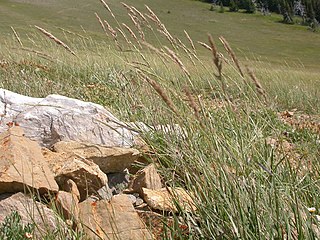
Calamagrostis purpurascens, is a perennial grass commonly known as purple reedgrass, purple pinegrass, or alpine reedgrass It grows 30 to 80 centimetres (31 in) tall.

The crested guan is a member of an ancient group of birds of the family Cracidae, which are related to the Australasian mound builders. It is found in the Neotropics, in lowlands forests ranging from south Mexico and the Yucatán Peninsula to western Ecuador and southern Venezuela. The sexes are similar in appearance; the plumage is mainly dark brown with white spotting, an area of bare skin round the eye, bright red wattles, a bushy crest, a long broad tail and pink legs. It is a social bird, often seen in pairs or small family groups. It feeds in trees, mainly on fruit, and builds a nest of twigs on a branch. The two or three white eggs are incubated by the female. The International Union for Conservation of Nature has rated this bird's conservation status as "least concern".
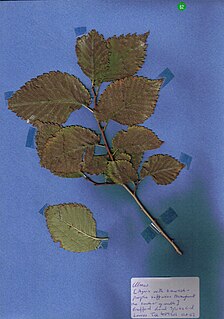
The Field Elm cultivar Ulmus minor 'Purpurascens' was listed by Lavallée in Arboretum Segrezianum (1877) as U. campestris var. purpurascens (purpurea), but without description, and later by Schneider in Illustriertes Handbuch der Laubholzkunde (1904). Krüssmann in Handbuch der Laubgehölze (1962) identified it as a cultivar.

Ptisana purpurascens is a large fern belonging to the botanical family Marattiaceae. It has a globular rhizome with stipule-like fleshy outgrowths. The leaves are dark green, twice pinnate and up to 1 metre long. Every pinnule has up to six pairs of leaflets. The petioles are dark-purplish, hence the name 'purpurascens' meaning 'becoming purple'. The sporangia are fused in all Ptisana into a bivalvate synangium.
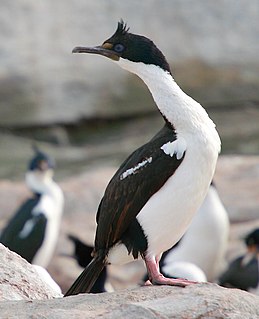
The imperial shag or imperial cormorant is a black and white cormorant native to southern South America, primarily in rocky coastal regions, but locally also at large inland lakes. Some taxonomic authorities, including the International Ornithologists' Union, place it in the genus Leucocarbo, others in the genus Phalacrocorax. It is also known as the blue-eyed shag, blue-eyed cormorant and by many other names, and is one of a larger group of cormorants called blue-eyed shags. The taxonomy is very complex, and several former subspecies are often considered separate species.

The purple indigobird is a species of bird in the family Viduidae. It is also known as the dusky indigobird, a name which can refer to Vidua funerea. It is found in Angola, Botswana, Democratic Republic of the Congo, Kenya, Malawi, Mozambique, South Africa, Tanzania, Zambia, and Zimbabwe. Its natural habitat is dry savanna.
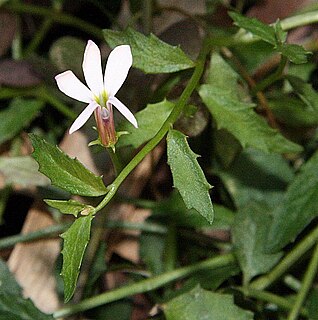
Pratia purpurascens, commonly known as white root, is a small herbaceous scrambling herb of eastern Australia. reaching 15 cm (6 in) high, it grows in damp, sheltered areas. It was initially described by the Scottish botanist Robert Brown as Lobelia purpurascens.

Tasmannia purpurascens, commonly known as the broad-leaved pepperbush or purple pepperbush is a shrub in the primitive family Winteraceae and is only found growing in the Barrington Tops and Ben Halls Gap regions of New South Wales. It is locally abundant in a restricted subalpine habitat with a high rainfall, often growing in the ecotone in association with Antarctic Beech.
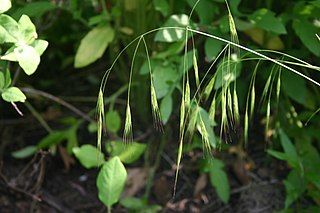
Schizachne is a genus of Eurasian and North American plants in the grass family. The only accepted species is Schizachne purpurascens, commonly called false melic. Three subspecies are recognized:

Conus purpurascens, common name the purple cone, is a species of sea snail, a marine gastropod mollusk in the family Conidae, the cone snails and their allies.

Cyclamen purpurascens is a species of flowering plant in the genus Cyclamen of the family Primulaceae, native to central Europe, northern Italy, and Slovenia. It is a tuberous perennial with (usually) variegated leaves, and deep pink flowers in summer.
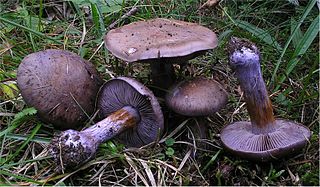
Cortinarius purpurascens, also known as the bruising webcap, is a basidiomycete mushroom of the genus Cortinarius. The fruit bodies grow in groups on the ground in coniferous forests, throughout the temperate zone of the Northern Hemisphere, including Europe and North America.

Hygrophorus purpurascens, commonly known as the veiled purple hygrophorus, is a species of agaric fungus in the family Hygrophoraceae. Its cap has a pink background color with streaks of purplish red overlaid, and mature gills have red spots.

Othorene is a genus of moths of the family Saturniidae. The genus was erected by Jean Baptiste Boisduval in 1872.
Othorene verana is a species of moth of the family Saturniidae.
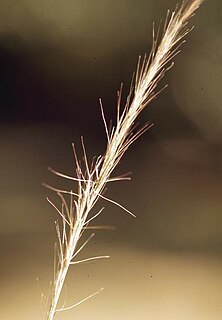
Aristida purpurascens is a species of grass known by the common name arrowfeather threeawn. It is native to eastern North America. One of the three varieties has a distribution extending south into Honduras.
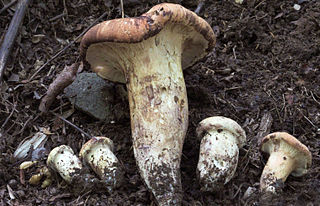
Gloeocantharellus purpurascens, commonly known as the Indian Creek mushroom or violet-staining chanterelle, is a species of fungus in the family Gomphaceae native to North America and French Guyana.

The Elm cultivar Ulmus 'Myrtifolia Purpurea', the Purple Myrtle-leaved Elm, was first mentioned by Louis de Smet of Ghent (1877) as Ulmus myrtifolia purpurea. An U. campestris myrtifolia purpureaHort. was distributed by Louis van Houtte in the 1880s, by the Späth nursery, Berlin, in the 1890s and early 1900s, and by the Hesse Nursery, Weener, Germany, till the 1930s.

The brown kukri snake is a species of snake of the family Colubridae.



















